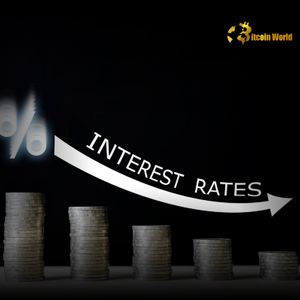Interest Rate Cut: Analyzing the Potential Boost for the Crypto Market
8 min read
BitcoinWorld Interest Rate Cut: Analyzing the Potential Boost for the Crypto Market The world of finance is constantly reacting to signals from key economic players, and few voices carry as much weight as that of a U.S. President. Recently, Donald Trump made headlines by suggesting that a 2.5 percentage point interest rate cut by the U.S. Federal Reserve would be a desirable move. While seemingly a comment focused solely on traditional U.S. economics, such pronouncements and potential shifts in monetary policy have significant ripple effects that can extend even to the dynamic crypto market . But how exactly does a change in the cost of borrowing money in the U.S. potentially influence assets like Bitcoin, Ethereum, and the myriad of altcoins? Understanding the Power Behind the Federal Reserve Before diving into the potential economic impact on digital assets, it’s crucial to understand the entity Trump was addressing: the Federal Reserve . Often referred to as the ‘Fed,’ this is the central banking system of the United States. Its primary role is to conduct national monetary policy , supervise and regulate banking institutions, maintain the stability of the financial system, and provide financial services to depository institutions, the U.S. government, and foreign official institutions. One of the Fed’s most powerful tools is setting the target range for the federal funds rate. This is the interest rate at which depository institutions lend reserve balances to other depository institutions overnight. While not a direct consumer rate, it influences other interest rates throughout the economy, including: Prime rates for loans Mortgage rates Car loan rates Credit card interest rates Savings account yields Essentially, the federal funds rate is the bedrock upon which much of the U.S. financial system’s borrowing and lending costs are built. A 2.5% reduction, as suggested, would be a substantial cut, indicating a significant shift in the Fed’s stance. Why Talk About an Interest Rate Cut? The Goals of Monetary Policy The Federal Reserve adjusts interest rates primarily to achieve its dual mandate from Congress: maximum employment and stable prices (low, stable inflation). Lowering interest rates is typically a tool used to stimulate the economy. Here’s a simplified look at the intended effects of an interest rate cut : Lower Borrowing Costs: Businesses and consumers can borrow money more cheaply for investments, expansion, and purchases. This encourages spending and economic activity. Increased Investment: With lower returns on safer assets like bonds or savings accounts, investors might be encouraged to put money into riskier, potentially higher-yielding assets. Currency Devaluation (Potential): Lower interest rates can make a country’s currency less attractive to foreign investors seeking yield, potentially leading to a weaker currency. This can make exports cheaper and imports more expensive, theoretically boosting domestic production. Inflationary Pressure: More money flowing through the economy can lead to increased demand for goods and services, potentially pushing prices up. The Fed aims for moderate inflation, often targeting around 2%. Conversely, raising rates aims to cool down an overheating economy, combat high inflation, and potentially slow down asset price growth. Trump’s comment about a 2.5% cut suggests a belief that the economy needed significant stimulus, or perhaps that current rates were too restrictive. What is the Potential Economic Impact of Such a Significant Cut? A 2.5% reduction in the federal funds rate is not a minor adjustment; it represents a dramatic shift in monetary policy . To put it in perspective, rate cuts are usually done in 0.25% increments, sometimes 0.50%. A 2.5% cut would likely only happen during a severe economic downturn or crisis, or if rates were exceptionally high to begin with. At the time of Trump’s comment, rates were relatively low compared to historical averages, making a 2.5% cut seem quite aggressive outside of a recession scenario. The potential economic impact would be widespread: Boost to Borrowing and Spending: Mortgages, car loans, business loans would become significantly cheaper, likely spurring consumer spending and business investment. Stock Market Reaction: Lower interest rates often make stocks more attractive compared to bonds, as borrowing costs for companies decrease and future earnings are discounted at a lower rate. This could lead to a stock market rally. Real Estate: Lower mortgage rates would likely boost housing demand and potentially property prices. Savings Accounts: Yields on savings accounts and CDs would plummet, forcing savers to look elsewhere for returns. Inflation Watch: A rapid and large rate cut could risk unleashing inflationary pressures if the economy is not in need of such strong stimulus. While a President can voice opinions, the Federal Reserve operates independently of the executive branch. This independence is considered crucial for making sound monetary policy decisions free from political pressure. However, presidential comments can still influence market sentiment and public perception. How Does an Interest Rate Cut Potentially Influence the Crypto Market? This is where the traditional financial world intersects with the digital asset space. The relationship between interest rates and the crypto market is not always direct or simple, but there are several key mechanisms through which they can interact: 1. The Search for Yield: In a low-interest-rate environment, traditional safe-haven assets like savings accounts, money market funds, and government bonds offer very low returns. Investors, especially large institutions and funds, are constantly seeking better yields. This ‘search for yield’ can push capital into riskier asset classes, including stocks, real estate, and potentially, cryptocurrencies. When the cost of borrowing is low, it’s also cheaper for institutions and individuals to leverage investments, potentially increasing the flow of capital into markets like crypto that offer the potential for high returns (albeit with high risk). 2. Risk-On vs. Risk-Off Sentiment: Generally, lower interest rates are associated with a ‘risk-on’ environment. This means investors are more willing to take on risk in pursuit of higher returns. Higher interest rates, conversely, can create a ‘risk-off’ environment, where investors prefer safer assets. As a relatively new and volatile asset class, cryptocurrency is often considered a ‘risk-on’ investment. Therefore, a shift towards a risk-on sentiment driven by lower rates could potentially benefit the crypto market . 3. Inflation Hedge Narrative: One of the arguments for owning Bitcoin, in particular, is its perceived role as a hedge against inflation due to its fixed supply. If a large interest rate cut were to spark fears of rising inflation (as injecting significant liquidity into the economy could do), the narrative around Bitcoin and other deflationary cryptocurrencies as stores of value might strengthen, potentially increasing demand. 4. Liquidity in the System: Lower rates are part of a broader easing of monetary policy , which generally increases the overall liquidity in the financial system. More money circulating and seeking returns can find its way into various asset classes, including crypto. 5. Comparison to Traditional Assets: When bond yields are low, the opportunity cost of holding volatile assets like crypto decreases. If a ‘safe’ 10-year Treasury bond only yields 1-2%, the prospect of volatility in crypto for potentially much higher returns becomes more appealing to some investors compared to a scenario where the bond yields 4-5%. Historical Context: Looking back, periods of aggressive monetary easing, such as after the 2008 financial crisis (though crypto didn’t exist then) and during the COVID-19 pandemic, coincided with significant rallies in risk assets, including the crypto market . While correlation doesn’t equal causation, the increased liquidity and search for yield during these times are often cited as contributing factors to crypto’s growth. Potential Challenges and Risks for Crypto While lower rates can present potential tailwinds for the crypto market , it’s not without risks: Inflation Concerns: While some see crypto as an inflation hedge, runaway inflation could also destabilize economies and lead to broader market panic, potentially dragging crypto down with other assets. Asset Bubbles: Excess liquidity and low borrowing costs can contribute to asset bubbles. A sudden correction in traditional markets fueled by inflated valuations could negatively impact crypto. Regulatory Response: Significant shifts in monetary policy and economic conditions can sometimes trigger increased scrutiny or changes in regulation for newer asset classes like crypto. Dependency on Traditional Markets: Despite the narrative of decentralization, the crypto market is still significantly influenced by macroeconomic factors and the performance of traditional financial markets. A sharp downturn in stocks or bonds, even if initially triggered by rate changes, could spill over. Political Uncertainty: Presidential comments on Fed policy, while not dictating action, highlight the potential for political factors to influence economic discussion, which can add a layer of uncertainty to market sentiment. Actionable Insights for the Crypto Investor Given the potential connections between monetary policy and the crypto market , what should an investor consider? 1. Stay Informed on Macroeconomics: Don’t just follow crypto news. Pay attention to announcements from the Federal Reserve , inflation data, employment reports, and statements from key economic figures. These factors influence the broader financial environment that crypto operates within. 2. Understand Correlation, Not Just Causation: Recognize that while there can be correlations between interest rate movements and crypto price action, numerous other factors influence the market (technological developments, regulatory news, adoption rates, market sentiment specific to crypto, etc.). Lower rates are one potential factor, not the only driver. 3. Assess Your Risk Tolerance: A low-rate environment might push some towards riskier assets, but it doesn’t change the inherent volatility of the crypto market. Only invest what you can afford to lose. 4. Consider Diversification: Don’t put all your eggs in one basket. Your overall investment portfolio should align with your financial goals and risk profile, potentially including a mix of traditional and digital assets. 5. Long-Term Perspective: While macroeconomic events can cause short-term price swings, many crypto investors focus on the long-term potential of the underlying technology and network effects. Consider your investment horizon. 6. Watch for Market Sentiment Shifts: Observe how the market reacts to Fed announcements and economic data. Is the prevailing sentiment risk-on or risk-off? This can provide clues about potential capital flows. A table summarizing potential effects: Monetary Policy Action Potential Economic Effect Potential Crypto Market Effect Interest Rate Cut Stimulates borrowing & spending, lowers returns on safe assets, potentially increases inflation risk. Increased search for yield, ‘risk-on’ sentiment, potential boost from inflation hedge narrative, increased liquidity. Interest Rate Hike Slows borrowing & spending, increases returns on safe assets, combats inflation. Decreased search for yield, ‘risk-off’ sentiment, reduced liquidity, increased opportunity cost vs. traditional assets. It’s important to remember that the Federal Reserve makes decisions based on a wide range of economic data and forecasts, not presidential requests. However, such requests highlight the political desire for certain economic outcomes, which can still influence the public discourse and market expectations. Concluding Thoughts: Connecting the Dots While Donald Trump’s suggestion of a 2.5% interest rate cut was a statement directed at traditional U.S. monetary policy , its implications ripple outwards. For the crypto market , which exists within the broader global financial ecosystem, shifts in interest rates and the resulting economic impact are relevant factors to monitor. Lower rates can potentially create an environment more favorable to risk assets by increasing liquidity and the search for yield, reinforcing certain narratives within the crypto space. However, the relationship is complex, influenced by numerous other variables, and the crypto market retains its own unique drivers and volatility. Investors should view macroeconomic signals, including discussions around interest rates by figures like the President and actions by the Federal Reserve , as important pieces of the puzzle, but not the sole determinants of crypto’s trajectory. Understanding these connections allows for a more informed perspective on the potential forces shaping the digital asset landscape. To learn more about the latest crypto market trends, explore our article on key developments shaping the crypto market institutional adoption. This post Interest Rate Cut: Analyzing the Potential Boost for the Crypto Market first appeared on BitcoinWorld and is written by Editorial Team

Source: Bitcoin World



